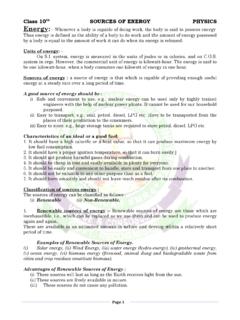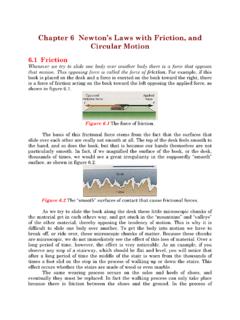Transcription of Force and Laws of Motion - Green Valley …
1 CLASS:9th Force and laws of Motion PHYSICS. Force :- Force may be defined as an influence, which tend to change state, speed, direction and shape of a body. It has both magnitude and direction and is therefore, a vector quantity. It may also be defined as an external agency, which changes the speed and direction of a body. It can also change the shape of a body. Force is a vector quantity. It is represented by an arrow. Units of Force : In system, Force is measured in Newton's represented by letter N while as in system its values are represented in dynes. Newton:- The Force applied is said to be one dyne if it produces acceleration of 1cm/sec2 and in a body of mass 1Kg. Dyne:- The Force applied is said to be one dyne if it produces acceleration of 1cm/sec2 in a body of mass 1 gram. Effects of Force :- Some of the common effects of Force are:- 1. A Force may move a body at rest. For example, when we kick a football kept on the ground with our foot, the football moves.
2 The Force applied by our foot moves the ball. 2. A Force may stop a moving body. For example, when a player catches a moving cricket ball, the Force applied by player's hands stops the moving ball. 3. A Force can change the speed of a body. For example, when a ball is dropped from a certain height, the speed of the ball goes on increasing due to gravitational pull of the Earth on the ball, in the downward direction. Thus Force applied by the Earth in the direction of Motion of the ball increases the speed of the ball. 4. A Force may change the direction of a moving body. For example, when a moving cricket ball is hit by a bat, the cricket ball moves in a different direction. The Force applied by the bat changes the direction of the moving cricket ball. 5. A Force may change the size and shape of a body. For example, when we press a rubber ball or a balloon between our two hands, the shape of the rubber ball or balloon changes from spherical to ablong.
3 The forces applied by our hands change the shape of the rubber ball/balloon. Forces can be classified into two classes:- 1. Contact forces 2. Action at a distance forces. 1. The contact forces represent the result of physical contact between two objects, one by which Force is exerted and the other on which Force is exerted pulling of a coiled spring, pulling of a cart. 2. The action at a distance forces are the forces, which do not involve physical contact between the two objects but act through the space between the two the gravitational Force , electrical Force etc. Types of Force :- Forces are of main two types, viz. (i). Balanced Force :- A Force is said to be balanced if the resultant of all the forces acting on a body is equal to 0. A body under the influence of a balanced Force does not change its position of rest or uniform Motion and appears as if no Force is acting on it. For example: In the game of tug of war, the two teams pull each other in the opposite directions.
4 If the two teams pull the rope with equal Force F1 = F2, then the rope does not move in either direction. Under this condition, the forces acting on a rope are balanced forces. (ii). Unbalanced Force :- A Force is said to be unbalanced if the resultant of all the forces acting on a body is not equal to 0. A body under the influence of unbalanced Force changes its position of rest and uniform Motion . For example. In the tug of war, if the Force applied by a team is greater than that applied by the other team. Then the members of the weaker team will be pulled towards the stronger team. Thus, the unbalanced forces produce Motion . Force of Reaction Force of Reaction Force of Friction Force of Push Force of Friction Force of Push BALANCED UNBALANCED. Weight Force . Weight Force . -1- CLASS:9th Force and laws of Motion PHYSICS. Newton's laws of Motion : (1692 1772) Newton devised three basic laws based on his name, to describe Motion . All these laws are known as Newton's laws of Motion and are explained as under:- Newton's First Law of Motion or Galileo's Law of Inertia:- It states that, Everybody continues to remains in the state of rest or uniform Motion in a straight line until or unless completed by some external Force to change its state of rest or Motion .
5 In other words, the first law of Motion recognizes that everybody has some inertia i-e the property of a body to remain in a state of rest or uniform Motion . This law is accordingly also known as, Law of inertia . For example: (i) A book lying on a table will remain there unless and until somebody will come and change its place. (ii) A cricket ball will remain in Motion after hit by the player unless and until the Force of friction and the resistance of air stop it and changes its Motion into rest. Inertia:- The word inertia means unchanging. It has been derived from the Latin word inert. It is defined as the property of a body to remain in the state of rest or uniform Motion . In other words, inertia may be defined as the property of a body to remain in the state of rest or uniform Motion . In other words, inertia may be defined as the inability of a body to change its any state. A heavier body has more inertia than a lighter body. Therefore, we can say that The larger the mass, the larger is the inertia, and smaller the mass, smaller is the inertia.
6 In other words we can say that The mass of a body is a measure of its inertia. It is of three main types:- (i). Inertia of Rest:- It is the inability of a body to change its rest or its property to remain in rest. This means a body at rest remains at rest and cannot start moving on its own. (ii). Inertia of Motion :- It is the inability of a body to change its state of Motion or its property of a body to remain in the same direction for example Balls bowled by a bowler remain in same direction until it is played of the batsman. (iii) Inertia of direction:- It is the inability of a body to change by itself its direction of Motion , , a body moving along a straight line will continue to move along the same direction unless some external Force compels it to change the direction of Motion . Examples of inertia Why are passengers thrown in the forward direction when a running bus stops suddenly? Passengers sitting or standing in a running bus share the Motion of the bus.
7 This means, the passengers in a running bus are also moving with the same speed in the same direction. When the running bus stops suddenly, the lower part of the passenger's body comes to rest, while the upper body portion continues to remain in Motion . As a result, the passengers are thrown in the forward direction when a running bus stops suddenly. Why do Passengers tend to fall side ways the bus takes a sharp turn? When a bus runs along a straight-line path, all the passengers traveling in the bus also move with the same speed in the same direction. When the bus takes a sharp turn, the upper body portion of the passengers still continues to move in the original (straight line) path, while the lower portion tends to turn with the bus. As a result, passengers tend to fall/ lean side ways. Why should a passenger hold on to a support to prevent himself from swaying in a turning bus? A person traveling in a bus shears the Motion of the bus. When the bus takes a turn, it changes its direction of Motion .
8 The passenger due to his inertia of Motion , however, continues to move in the original direction. So, if the passenger does not hold on to a support, he will be swayed away. Why do passengers in a bus tend to fall backward when it starts suddenly? When a passenger in sitting or standing in a stationery bus, both the bus and the passenger are at rest. When the bus starts moving suddenly, the lower part of the passenger's body starts moving forward with the bus. The upper part of the body tends to remain in the position of rest due to its inertia of rest. As a result, therefore, the passenger falls or leans backwards. Similarly a rider on horseback falls backwards when the horse suddenly starts running. Why does a passenger jumping out of a rapidly moving bus fall forward with his face downwards, if he does not run forward? A passenger traveling in a bus shares the Motion of the bus. Thus, the passenger's body is moving in the direction of the bus with the same speed.
9 When a passenger jumps out of a fast moving bus, his feet on touching the ground come to rest, whereas the upper part of his body continues to move forward due to inertia of Motion . As a result, if he does not run forward he falls with his face downwards. -2- CLASS:9th Force and laws of Motion PHYSICS. Why can dust be removed from a carpet by shaking it, or by beating it with a stick? Initially, both the carpet and the dust therein are at rest. When the carpet is shaken, or beaten with a stick, the carpet is set into Motion . Due to inertia of rest, the dust particles tend to remain at rest. As a result, the dust particles fall off. Newton's Second Law of Motion :- According to Newton's second law of Motion , the rate of change of linear momentum of a body is directly proportional to the external Force applied on the body, and this change takes place always in the direction of the applied Force . Now, the rate of change of linear momentum of a body can be obtained by dividing change in linear momentum'.
10 Of the body by the time taken' for this change. Thus, according to Newton's second law of Motion , change in linear momentum Force applied time taken Mathematical formulation of Newton's second law of Motion :- Suppose m = mass of body, u = initial velocity of the body along a straight line, F = an external Force applied on the body, which is constant in magnitude, t = time for which the Force is applied v = Final velocity of the body along the same straight line, after t second. Initial linear momentum of the body, P1 = mu Final linear momentum of the body, P2 = mv Change in linear momentum of the body = p2 p1. = mv mu = m (v u). change in linear momentum Rate of change of linear momentum =. time taken m (v - u). = ..(i). t (v - u). But = rate of change of velocity = acceleration of the body = a t Therefore from equation (i), rate of change of linear momentum = ma According to Newton's second law of Motion , rate of change of linear momentum Force applied Therefore ma F.








